- By Dan Veaner
- News
 Print
Print
The oldest log cabin in Tompkins and Cayuga Counties was built in Lansing in 1749 near the intersection of Searles and Conlon Roads. Since then it has been moved at least three times, spending nearly 50 years in Auburn before it was brought home to Lansing this year. It came one step closer to being restored Saturday when about a half dozen Cornell students restacked the logs to make them safe for Winter. Town Councilman Bud Shattuck says that the restacking will prevent damage to the logs during the winter while a committee of volunteers decides where it will be assembled.
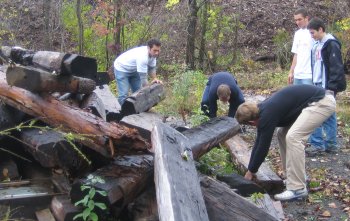
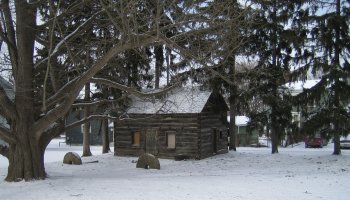
The cabin is 18' x 24' and while some walls are broken up by doors or windows, some of the logs are the full 24' long. They are somewhat squared off with notches at the ends that hold the walls together. When assembled a second floor is in the attic space. Only the four walls are original to the cabin. A roof was built when the cabin was moved to Auburn, and a new roof will be built when it is reassembled here. Several of the logs are damaged by rot, and were further damaged in the move. These will have to be replaced when the cabin is restored.
Several possible sights will be considered by the committee over the coming winter. Some are privately owned while others are already owned by the Town. Shattuck says he would like enough space to pour a concrete slab to reassemble the cabin on, as well as a few parking spaces. Town officials have spoken of a 'Lansing Historical Trail' with maps visitors could follow to see each site. Similarly to the Field School House, the log cabin would only be opened by appointment, but would have signage outside explaining its history and significance to the town.
The cabin is steeped in Lansing history. It was originally built by the North family, settlers in the area a good 27 years before the nation was formed. They are the same family that eventually migrated west to Michigan, where they named their new home after their old one here in Lansing.
At that time almost two million acres of Central New York was divided into military tracts of at least 100 acres to compensate Revolutionary War soldiers. The land was divided into 28 townships. Milton Township included what is now the Towns of Lansing and Genoa, and in 1808 the township was renamed Genoa. When Tompkins County was formed in 1817, the Town of Lansing was split off from Genoa to be part of the new southern county. Coincidentally the land was granted by John Lansing, Secretary to General Schuyler in the 1700s. The town was actually named for another John Lansing, who was a Supreme Court Jurist, and State Chancellor in 1817.
The cabin was sold in 1839, then moved to 578 Conlon Road. It was sold again in 1853, and as time went on a larger house enveloped the cabin. A hundred years later nobody remembered that the house had originally been a log cabin. It had been covered with pine siding that integrated the old building with newer construction. In 1958 some of that siding was removed to effect repairs, and the cabin was rediscovered.
Later that year it was transported to the Cayuga Museum in Auburn, where it was used to house historical displays. When the museum decided to use the space for other purposes last year the Town of Lansing negotiated to bring it home. This summer the Lansing Highway Department disassembled the cabin log by log, tagging each one so that it could be restored later, and transported the logs to a concrete slab near their buildings.
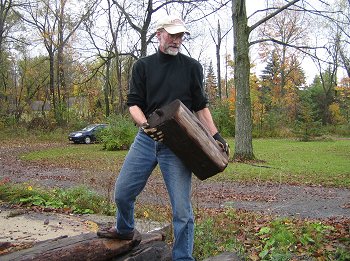
Shattuck says the Town will cover the logs with a tarpaulin to help prevent further damage. There is no budget for this project, so he hopes to reassemble it next year using volunteer labor. He has also investigated the possibility of grants, and says that taxpayer money will not be used for the project.
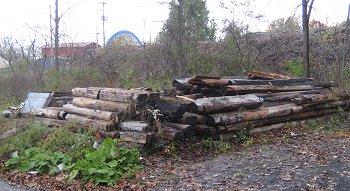
When completed Lansing will display a piece of its heritage that will remind residents and visitors of the town's rich history, and open a window to show what life was like here more than 240 years ago.
----
v3i42

Volunteers from Cornell heave logs to stack them neatly
The students are part of the Community Partnership Board, a student run program that develops and participates in community projects at the grass roots level. The board can provide grants for projects, or students who want to contribute to local projects. Shattuck applied for about a dozen volunteers to sort, tag, and cover the logs to prepare them for the winter and for eventual reassembly.

The North Log Cabin before disassembly at the Cayuga Museum
 Click to see Time Line  Click to see Map 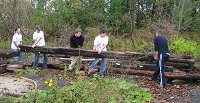 24 foot logs needed five students to lift their weight 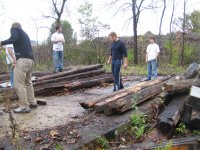 A concrete slab that used to hold large tanks is swept before stacking the logs 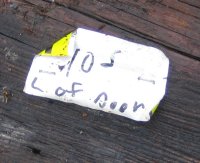 Metal tags were carefully labled to aid in reassembly | ||
Several possible sights will be considered by the committee over the coming winter. Some are privately owned while others are already owned by the Town. Shattuck says he would like enough space to pour a concrete slab to reassemble the cabin on, as well as a few parking spaces. Town officials have spoken of a 'Lansing Historical Trail' with maps visitors could follow to see each site. Similarly to the Field School House, the log cabin would only be opened by appointment, but would have signage outside explaining its history and significance to the town.
The cabin is steeped in Lansing history. It was originally built by the North family, settlers in the area a good 27 years before the nation was formed. They are the same family that eventually migrated west to Michigan, where they named their new home after their old one here in Lansing.
At that time almost two million acres of Central New York was divided into military tracts of at least 100 acres to compensate Revolutionary War soldiers. The land was divided into 28 townships. Milton Township included what is now the Towns of Lansing and Genoa, and in 1808 the township was renamed Genoa. When Tompkins County was formed in 1817, the Town of Lansing was split off from Genoa to be part of the new southern county. Coincidentally the land was granted by John Lansing, Secretary to General Schuyler in the 1700s. The town was actually named for another John Lansing, who was a Supreme Court Jurist, and State Chancellor in 1817.
The cabin was sold in 1839, then moved to 578 Conlon Road. It was sold again in 1853, and as time went on a larger house enveloped the cabin. A hundred years later nobody remembered that the house had originally been a log cabin. It had been covered with pine siding that integrated the old building with newer construction. In 1958 some of that siding was removed to effect repairs, and the cabin was rediscovered.
Later that year it was transported to the Cayuga Museum in Auburn, where it was used to house historical displays. When the museum decided to use the space for other purposes last year the Town of Lansing negotiated to bring it home. This summer the Lansing Highway Department disassembled the cabin log by log, tagging each one so that it could be restored later, and transported the logs to a concrete slab near their buildings.

Town Councilman Bud Shattuck holding a log with a wooden pin to hold it in place
Shattuck says the Town will cover the logs with a tarpaulin to help prevent further damage. There is no budget for this project, so he hopes to reassemble it next year using volunteer labor. He has also investigated the possibility of grants, and says that taxpayer money will not be used for the project.

By late Saturday afternoon, the cabin was stacked, ready to be covered for the winter
When completed Lansing will display a piece of its heritage that will remind residents and visitors of the town's rich history, and open a window to show what life was like here more than 240 years ago.
----
v3i42



